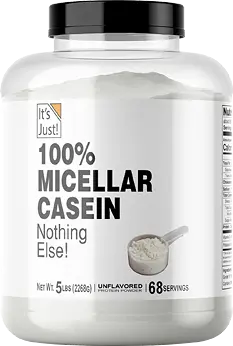Knowledge BaseYou're Questions Answered
Can you mix casein protein powder with milk?
Casein protein powder is a slow-digesting protein derived from milk, popular for its ability to provide a steady release of amino acids over several hours. It is commonly used as a nighttime protein supplement or during periods when prolonged protein intake is beneficial. One common question is whether casein protein powder can be mixed with milk, and if so, what the benefits and considerations are.
Mixing Casein Protein Powder with Milk
Yes, you can mix casein protein powder with milk, and doing so can provide additional nutritional benefits and improve the taste and texture of your shake. Here’s why mixing casein protein powder with milk can be advantageous:
1. Enhanced Protein Content
Mixing casein protein powder with milk increases the overall protein content of your shake. A typical serving of casein protein powder provides around 24-26 grams of protein, and adding 8 ounces of milk can contribute an additional 8 grams of protein, depending on whether you use whole, low-fat, or skim milk1. This combination helps meet higher protein needs for muscle recovery and growth.
2. Improved Taste and Creaminess
Mixing casein protein with milk results in a creamier, richer texture compared to water. This can enhance the overall taste and make the shake more satisfying, especially when using flavored casein protein powders like chocolate or vanilla. The natural sugars in milk (lactose) also add a subtle sweetness that can complement the flavor profile of the protein powder.
3. Additional Nutrients
Milk provides essential nutrients such as calcium, vitamin D, and potassium. These nutrients support bone health and overall wellness, adding extra nutritional value to your protein shake2. Using milk instead of water can be especially beneficial for those looking to increase their intake of these vitamins and minerals.
Considerations When Mixing with Milk
- Calorie Count: Mixing casein protein powder with milk will increase the calorie content of your shake. This can be beneficial for those aiming to gain muscle or weight but should be considered if you are trying to manage calorie intake for weight loss.
- Lactose Intolerance: Individuals who are lactose intolerant may experience digestive discomfort when mixing casein protein with milk. Lactose-free milk or a plant-based milk alternative can be used to avoid these issues while still achieving a creamy texture.
How to Mix Casein Protein Powder with Milk
- Choose Your Milk Type: Select the type of milk that aligns with your dietary goals (e.g., whole, 2%, skim, or lactose-free).
- Measure the Liquid: Pour 8 to 12 ounces of milk into a shaker bottle or blender.
- Add the Protein Powder: Add one scoop (around 30 grams) of casein protein powder to the milk.
- Mix Thoroughly: Shake vigorously for 20-30 seconds or blend for a smoother consistency.
- Optional Add-Ins: Enhance the shake with add-ins like banana slices, peanut butter, or a dash of cinnamon for extra flavor and nutrition.
- Hoffman, J. R., & Falvo, M. J. (2004). Protein–which is best? Journal of Sports Science & Medicine, 3(3), 118-130.
- Weaver, C. M., & Plawecki, K. L. (1994). Dietary calcium: Adequacy of a vegetarian diet. The American Journal of Clinical Nutrition, 59(5), 1238S-1241S.
Related Questions

Your Answer
We are a participant in the Amazon Services LLC Associates Program, an affiliate advertising program designed to provide a means for us to earn fees by linking to Amazon.com and affiliated sites.






